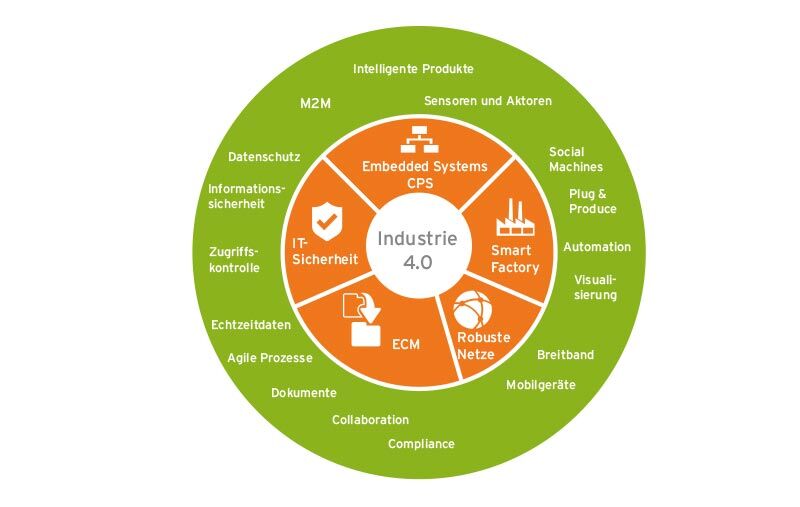SER Blog Innovation & Technology
Industry 4.0 needs a digital workspace
Franziska Thomas
When it comes to Industry 4.0, highly specialized solutions for embedded software, sensors and routing applications in production processes are only one side of the coin. For a true transformation, industrial companies need to fully digitize, automate and connect all areas of their businesses. Enterprise content management is the right tool for this.
Industry 4.0 requires that people, machines, products and business processes be even more interconnected in the future. In addition to a complete digitalization of all business areas, the automation of operations inside and outside of production processes also plays a crucial role. What does this mean for daily business? It means that all parts of the value chain have to be extremely well connected, and those involved in value chain must interact and communicate across all locations and country borders. The goal: to provide higher quality service through a more efficient use of resources, while also fulfilling customer requirements at consistently competitive prices. Ultimately, the focus of the industry of the future will not only be on producing large quantities of the same product at the lowest possible price, but more and more on manufacturing very small quantities or even customized productions.

Although many companies have already started to change their production processes and are taking the first steps towards becoming a smart factory, they often struggle with the digitalization and restructuring of their business processes. It's not enough to concentrate on production processes alone. The challenges of business transformation must be faced in every area of business. Those who factor in document-oriented areas and integrate them into processes will succeed in fully tapping the potential of Industry 4.0, as the following case from the automotive industry reveals.
Automotive supplier with international ECM strategy
Eissmann Group Automotive, a leading supplier of the automotive industry, produces complete car interiors, trim components, shifter modules and carbon components. Using the integrated ECM software suite Doxis by SER, the mid-sized company with 4,200 employees in 13 international locations digitizes and connects all business processes with an international IT strategy for a uniform corporate information management system.
The primary goal for Eissmann: quality assurance. In daily business, this means constantly logging and archiving the status of all processes. Behind this is a zero-mistake policy, guided by the concept of poka-yoke. This applies especially to the design, inspection and production of safety-oriented elements. For example, car airbags must function without error in an accident. To fulfill the customer's documentation requirements, the plant and machinery data (log files) are archived for every part of the production chain. In the case of airbags, all production data is directly transferred from the machinery in the production process into the Doxis File Import Service (FIPS) and archived in an audit-proof — i.e. tamper-free — way. This production data is available for inspection at any time and can be referred to as proof of properly manufactured parts. This also gives Eissmann security in liability issues.
Gain a competitive advantage with the digital workspace
Company-wide information management and connecting people, machinery and processes require high-performing IT support. Still, for efficient information management, it's not enough to have interface communication between various systems such as enterprise resource planning (ERP), customer relationship management (CRM), manufacturing execution systems (MES), CNC computerized numerical control (CNC), or computer-aided design (E-CAD). You also need software solutions that can digitize the entire value chain — from the first customer inquiry to production and, finally, to delivery.
With the Doxis Digital Workspace, information can be captured, collected, structured, archived, searched for and shared. It combines information according its content and provides it in context. The information workspace of a development department includes e.g. CAD drawings, factory standards, instructions for assembly, production and operation, parts lists, and safety regulations. The information space provides all of these documents across the globe. In mechanical and plant engineering, the digital workspace bundles all relevant data and documents in, for example, special records. In machinery and product life cycle records, documents from electronics, mechanics and IT are joined together and supplemented with further information from ERP, M-CAD and E-CAD system, emails, customer correspondences, inspection reports, maintenance documents or even production log files. They are all filed in the digital workspace as a single source of truth. The digital workspace gives information a space where employees can collaborate with suppliers, partners and customers across the globe and access information from anywhere and at any time.
Compliance in the era of Industry 4.0
The software behind the digital workspace, in other words the underlying technology in the "engine room", must be sustainable. Meaning, it must be high-performing, scalable and highly available to manage the masses of information from business processes, data and documents in a digital, secure, efficient and transparent way along the entire value chain.
The more connected and automated production and business processes are, however, the higher the requirements are for seamless documentation. Manufacturers are legally required to conduct, issue and deliver documentations of their machinery and plants. The documentation must conform with the law and always be up-to-date to fulfill the high level of requirements regarding safety, health, environmental protection, liability and warranty aspects, and quality assurance. Aside from internal and external compliance requirements, companies may also have to demonstrate and document their compliance with other laws, CE and EU directives, norms (especially DIN norms) or technical quality standards (ISO standards). Compliant documentation and audit-proof archiving help companies to qualify for certifications. Retention requirements are automatically fulfilled; compliance requirements are likewise upheld and documented. Process steps and approval are always transparent and traceable.
The latest digitization trends, laws and guidelines, and helpful tips straight to your inbox: Subscribe to our newsletter.
How can we help you?
+49 (0) 30 498582-0Your message has reached us!
We appreciate your interest and will get back to you shortly.




